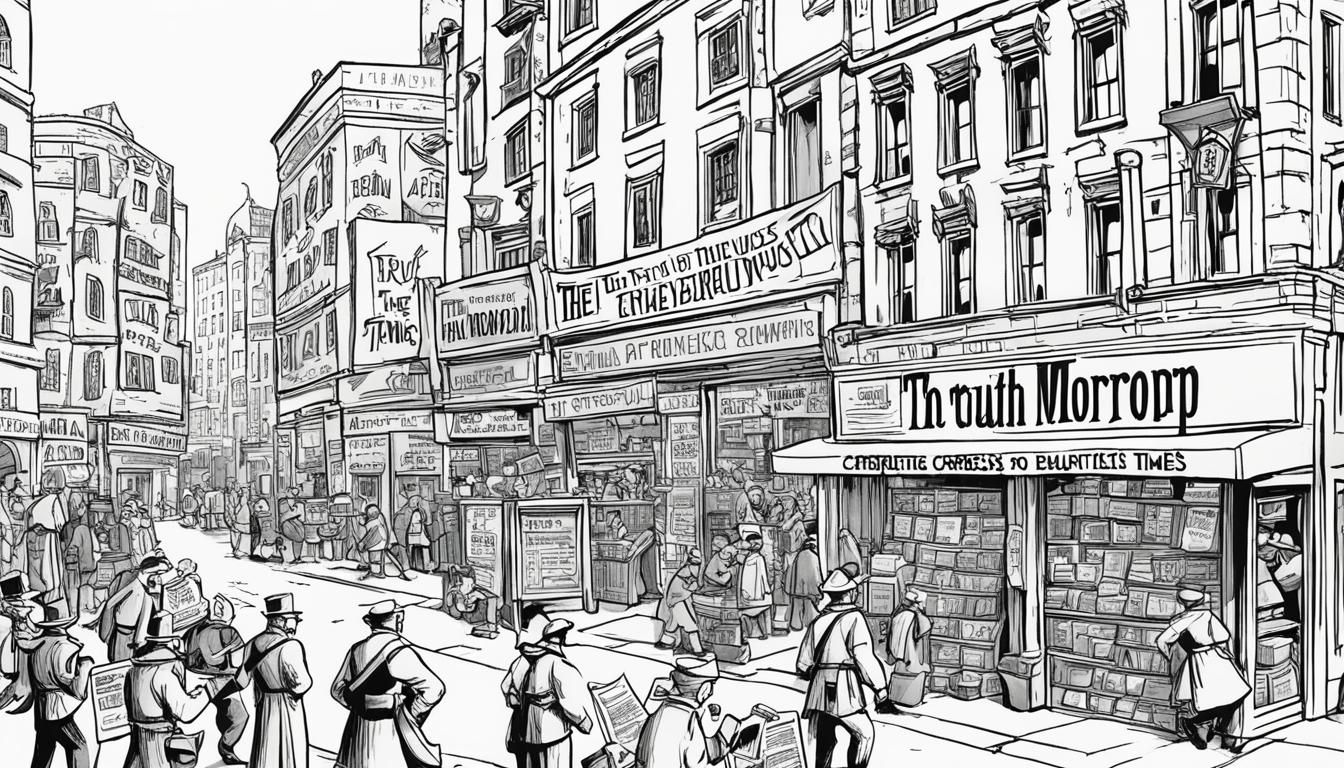Welcome to our engaging book summary of Terry Pratchett’s “The Truth,” the 25th installment in the Discworld series. In this article, we will explore the fantastical world of Discworld, filled with satire and adventure. If you are a fan of Terry Pratchett’s work or just looking for a new and exciting read, this book summary is perfect for you. Get ready to be transported to a world unlike any other with our comprehensive book summary.
Introduction to Discworld
Discworld is a captivating and unique fantasy world created by the late author Terry Pratchett. The series is set on a fictional flat planet balanced on the backs of four elephants that, in turn, stand on the back of a giant turtle. This whimsical world serves as the backdrop for Pratchett’s satirical and humorous novels.
Pratchett’s creation drew inspiration from a variety of sources, including J.R.R. Tolkien’s Middle-earth and the comedic writing of P.G. Wodehouse. Discworld stands out in the genre of fantasy world-building due to its irreverent take on typical fantasy elements and its incorporation of modern references.
Despite its fantastical qualities, Discworld often reflects contemporary issues and concerns. The series’ humorous and satirical tone allows Pratchett to explore social commentary while still providing a lighthearted and entertaining read.
With over 40 books published in the Discworld series, readers can experience a variety of unique characters and imaginative settings. As such, Discworld has become a beloved and enduring part of the fantasy genre, cementing Terry Pratchett’s legacy as a master storyteller.
Overview of “The Truth”
Following our introduction to Discworld, let’s dive into the book summary of Terry Pratchett’s “The Truth.” Set in the bustling city of Ankh-Morpork, this 25th Discworld installment showcases the power of journalism and the impact it can have on society as a whole.
William de Worde, the accidental hero of our story, finds himself stumbling into the world of newspaper publishing, igniting a firestorm of political unrest that tests the foundations of the city’s power structures. Through witty commentary and memorable characters, Pratchett weaves a narrative that keeps readers on the edge of their seats.
Prepare for a fascinating journey through Ankh-Morpork, teeming with both friend and foe, as William de Worde and his team strive for truth and journalistic integrity.
“‘The Truth’ reminds us that the pen is mightier than the sword – a timeless message that resonates with readers across generations.” – The New York Times
Main Characters in “The Truth”
William de Worde is the unlikely hero and main character who drives the narrative of “The Truth.” Starting the first newspaper in Ankh-Morpork, we see him evolve from a hesitant journalist into a daring and intrepid investigator. His quick wit, sharp insights, and penchant for journalism make him a compelling protagonist.
Other notable characters in “The Truth” include:
| Character | Description |
|---|---|
| Sacharissa Cripslock | A talented and resourceful reporter who works alongside William |
| Lord Vetinari | The Patrician of Ankh-Morpork, whose Machiavellian schemes keep the city running |
| Otto von Chriek | A vampire photographer who uses a unique method of capturing images |
The vividly imagined world of Terry Pratchett’s “The Truth” comes alive through a cast of colorful and eccentric characters. From the witty banter between William and Sacharissa to the intriguing machinations of Lord Vetinari, each character adds a unique flavor to the book’s narrative.
Themes and Satire in “The Truth”
In “The Truth,” Terry Pratchett uses satire as a means of exploring social and cultural issues in a thought-provoking way. One of the central themes of the book is the power of journalism and the role of the press in society. Through the character of William de Worde, Pratchett highlights the importance of accurate and honest reporting and the impact it can have on individuals and society as a whole.
Another theme present in the book is the examination of societal norms. As William de Worde navigates his way through the world of journalism, he comes face to face with corruption and the abuse of power. Pratchett uses these situations to shed light on the flaws of society and the need for change.
The author’s use of satire is also evident in the characters he creates. From the eccentric Lord Vetinari to the bumbling Klatchian photographer, each character has a distinct personality that adds to the humor and wit of the book. Pratchett’s ability to poke fun at societal norms and conventions while simultaneously highlighting their importance is what makes “The Truth” such a unique and enjoyable read.
“It was so much easier to blame it on Them. It was bleakly depressing to think that They were Us. If it was Them, then nothing was anyone’s fault. If it was Us, then what did that make Me? After all, I’m one of Us. I must be. I’ve certainly never thought of myself as one of Them. No one ever thinks of themselves as one of Them. We’re always one of Us. It’s Them that do the bad things.”
The Truth is a prime example of Terry Pratchett’s ability to use satire to tackle serious issues in a lighthearted and engaging way. The book’s clever commentary on society and culture adds a layer of depth to what is, at its core, a thrilling adventure story.
Plot Summary of “The Truth”
In “The Truth,” readers follow the journey of William de Worde as he starts the first newspaper in Ankh-Morpork, changing the power dynamics of the city. Soon, he finds himself embroiled in a conspiracy involving a new invention called the printing press, the city’s tyrant ruler, and the death of a prominent dwarf.
As William investigates the mysterious death, he uncovers a complex web of corruption and deceit, forcing him to face dangerous enemies and fight for the truth. Together with a cast of memorable characters, including Sacharissa Cripslock and Otto Chriek, William navigates the murky waters of politics and power while striving to uphold the principles of journalism.
Full of unexpected twists and turns, “The Truth” is a thrilling tale of courage, loyalty, and the pursuit of truth in a world where corruption and lies run rampant.
Key Events in “The Truth”
| Event | Summary |
|---|---|
| William starts the newspaper | William de Worde starts “The Ankh-Morpork Times” newspaper and realizes the power of journalism. |
| Death of Gunilla Goodmountain | A prominent dwarf is found dead, and William investigates the death. |
| The printing press | William discovers a new invention, the printing press, and realizes its potential to transform the world. |
| Conspiracy and corruption | William uncovers a conspiracy involving the city’s ruler, Lord Vetinari, and other powerful figures in Ankh-Morpork. |
| Uncovering the truth | William, along with Sacharissa and Otto, fights to reveal the truth and bring justice to Ankh-Morpork. |
“The Truth” is a remarkable tale of the power of journalism and the importance of the truth, set in the vibrant world of Discworld. With its engaging characters and exciting plot, it is sure to captivate readers and leave a lasting impression.
Writing Style and Language in “The Truth”
Terry Pratchett is known for his distinct writing style and masterful use of language, and “The Truth” is no exception. Pratchett’s prose is marked by its sharp wit, rich imagery, and clever wordplay, creating a unique reading experience that leaves a lasting impression.
One standout aspect of Pratchett’s writing style is his skill at creating vivid and memorable characters. From the main protagonist William de Worde to the supporting cast of colorful personalities, Pratchett imbues each character with their own unique voice and personality, making them feel incredibly lifelike and engaging.
“It wasn’t quite the city it had been, but then there was hardly a soul alive who was exactly the person they’d started out as, thought William.”
The author’s use of satire also plays a significant role in his writing. In “The Truth,” Pratchett employs satire to both entertain and challenge societal norms, using humor to expose underlying issues and prompt critical thinking among readers.
Pratchett’s writing in “The Truth” is a masterclass in wit, humor, and satire, making it a must-read for fans of the author’s work and anyone seeking an enjoyable and thought-provoking reading experience.
Impact and Reception of “The Truth”
Since its publication, “The Truth” has made a significant impact on both fans and critics of Terry Pratchett’s Discworld series. The book explores themes of power, corruption, and societal norms through the lens of journalism, shedding light on the importance of truth and accountability.
One of the elements that stood out to readers is the book’s witty and clever writing style, a hallmark of Pratchett’s works. “The Truth” showcases the author’s ability to blend humor with complex themes in a way that captivates readers.
The reception of “The Truth” has been overwhelmingly positive, with several critics hailing it as one of Pratchett’s best works. The book’s success has also paved the way for increased interest in the Discworld series, cementing its place in the science fiction and fantasy canon.
Overall, “The Truth” has left an indelible mark on the literary world and stands as a testament to Terry Pratchett’s talent and creativity.
Key Takeaways from “The Truth”
After exploring the world of “The Truth,” several key takeaways emerge:
- The power of journalism: William de Worde’s newspaper sends shockwaves through the city of Ankh-Morpork, demonstrating the potential of the press to hold those in power accountable.
- Satire as a mirror: Terry Pratchett’s unique brand of humor sheds light on societal norms, inviting readers to reflect critically on their own assumptions and beliefs.
- Character as core: Alongside the rollicking plot, Pratchett’s vividly drawn characters, such as William, Sacharissa Cripslock, and Lord Vetinari, remain the heart of the story.
- The enduring appeal of Discworld: “The Truth” serves as a testament to the enduring popularity of Terry Pratchett’s Discworld series, which has captivated readers with its humor, imaginative world-building, and incisive commentary for over three decades.
Quote:
“The truth will make you free. But first, it will piss you off.”
– Gloria Steinem
As we wrap up our summary of “The Truth,” we hope these key takeaways will stay with you as you explore the richly imagined world of Discworld.

Conclusion
In conclusion, our book summary of Terry Pratchett’s “The Truth” has provided an engaging overview of this witty and insightful novel. Taking readers on a journey through the satirical world of Discworld, “The Truth” showcases Pratchett’s unique writing style and clever use of language. Through its exploration of the power of journalism and examination of societal norms, this book leaves lasting impressions on its readers. We hope our summary has piqued your interest to delve deeper into the fantastical world of Terry Pratchett’s Discworld.
Thank you for reading our book summary of “The Truth.”



